Saddle fit - Western compared to English Part 2
We are no longer building saddle trees, but we have two videos about how Western saddles fit horses available on our westernsaddlefit.com website.
With the background I laid in the previous post of the importance of the history and therefore the design differences between English and Western saddles, I want to move on to talking about some of the "saddle fit rules" you can easily find on numerous websites all over the net. These "rules" vary in number depending on which site you are reading and they tend to be pretty standard with the occasional exception. But in all cases they come originally from the world of English saddles and are very commonly transposed directly onto western saddles without understanding that western saddles are designed very differently. So here is my assessment of these "rules" and how they do or do not apply to Western saddles.
#1 Position of the saddle
In English saddles, this is based on the position of the points relative to the shoulder blade. It is commonly taught that the points need to be about 2" behind the scapula. Extrapolating this to western, some (well known) people teach that the front bar tip on a western saddle therefore also needs to be 2" behind the scapula. However, the front bar tip on a western saddle actually belongs right behind the shoulder blade and it does not interfere with shoulder movement there when it is designed properly. We discuss the reasons why at length on our Proper Position of a Western Saddle page and show the pressure data as to why it works that way on our Rethinking Saddle Fit and Shoulder Blade Movement page and in our Proper Position of a Western Saddle video, so I won't go into more detail here. But like I said in the last post, for both English and Western saddles, it is the position of the saddle tree that determines the proper position of the saddle, not the rigging position, cinch/girth position, rider position, cantle position etc.
#2 Angle of the tree points
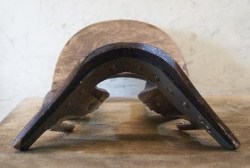 |
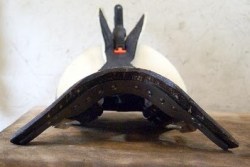 |
On an English saddle, the points are often quite straight and come down at a specific angle that can be measured. This "angle" is then supposed to match (or sometimes be within X number of degrees of) the "angle" of the withers of the horse (which really can't be measured on the curved surface of a horse), or you either have the ends of the points digging into the horse if the angle is too narrow or sticking off into space with all the pressure at the top of them if the angle is too wide. (English saddle tree pictures courtesy of Kitt from her blog.)
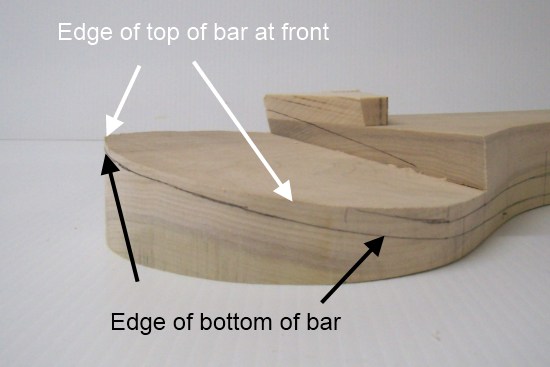
On Western saddles, we are dealing with a curved shape on the front bar pad that needs to match the shape of the withers. Yes, the bars are set at an angle relative to the fork based on the angle marked on the fork (our Bar Angles: Why the Numbers Are Meaningless Between Makers page explains more about this) but this angle does not carry over as a specific measurement to the horse side of the bars. Nor does the "angle" of the fork cut on the top of the bars tell us about the "angle" on the bottom of the bars because there are many other factors involved.
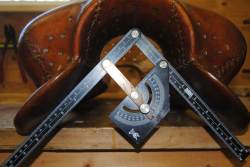 |
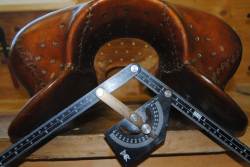 |
As for the bottom of the bars, when we are dealing with curves, where do we measure the angle? There really isn't one. However, the concept does apply. If the bars are "angled out" more than the horse, the top of the bars hit and the bottom sticks out into space. (See Padding doesn't fix mismatched "angles" for pictures of this.) If they are too narrow, the bottom of the bars hit and the top is not in contact with the horse. (See Ya gotta look inside for some pictures of this.) And since the front of the bar tends to have more constant pressure on it (because that is where the cinch primarily pulls, though the pull can be over more of the tree depending on rigging design) it is very important to get those front bar pads contacting the horse as closely as possible.
#3 Even panel (bar) contact front to back
This is one that is the same for both western and English (depending on your saddle fit philosophy, of course!). You want as much of the surface area of the panels (English) or bars (Western) on the horse as possible without bridging (missing the center with pressure front and back) or too much rock so that the saddle tips forward with the back end lifting off. Now, feeling for even contact in the middle of the saddle is a whole lot more difficult with a western saddle because as soon as you put your hand under the edge of the skirt, you are lifting the bar off the horse. But at least we know what we want to aim at.
However, you will find some people who say you should have some slight bridging to give the horse room to "round up" into the saddle. I also found one "list" that wanted the back end of the panel to come up off the horse "to allow the back to come up under engagement". Both of these (directly contradictory!) ideas of ways to give the horse room to round under the saddle go against the research showing that horses sag under weight. Even if horses could "round up" past their standing, unweighted position, (which research does not support) this would not happen in just a short stretch of the back, such as between the front and back bar pads or at the back end of the saddle. The whole back would lift.
That said, we do like to see the last inch or two of the back of the bars lifting off the horse a bit when a bare tree or saddle is placed on the horse. Why? Two reasons. Because with a rider on the saddle, the tree will press into the horse a bit and we want to avoid Poking at that back bar tip. If it is in contact with the horse when unweighted, it will probably become a high pressure point when weighted. And padding lifts the front more than the back and effectively takes out some rock.
#4 Clearing the top of the spine
I would almost call this a rule because it is that important, and it applies to any kind of saddle, even treeless ones. When there is minimal covering on the bone, such as the tops of the dorsal spinous processes, direct pressure can cause severe damage quite quickly.
However, you see "rules" that say you have to have a certain distance, specified most commonly in X numbers of fingers' width, of clearance. These probably started as rules of thumb to be used when people first saddle, because as you mount, the saddle gets lower on the horse with your weight. Then as you ride for a while and things pack down more, the clearance you had at the beginning of the ride is still less. And when you rope, there can be even more downward pressure. But there is no sacred distance that "must be". Our principle is that the saddle should never touch the top of the spine at any time, at any gait, at any phase of the stride, no matter what you are doing (roping, leaning forward to open a gate, etc.) Beyond that, a miss is as good as a mile.
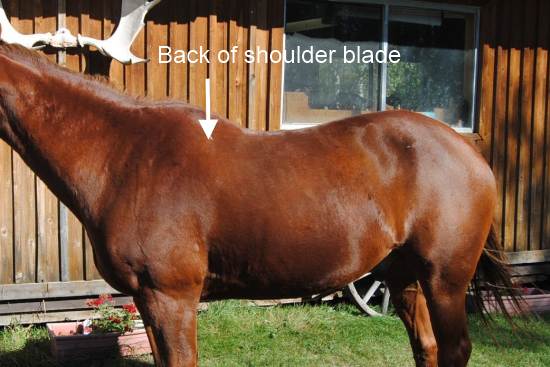
If you have a horse whose withers go back a long way relative to the shoulder blade, as seen in the horse above, the lip of the gullet may clear but the hand hole or the front of the groundseat (or the seat on an English saddle) may contact. (This is why both hand hole and gullet height is important. See our Avoiding the Withers page for more information.)
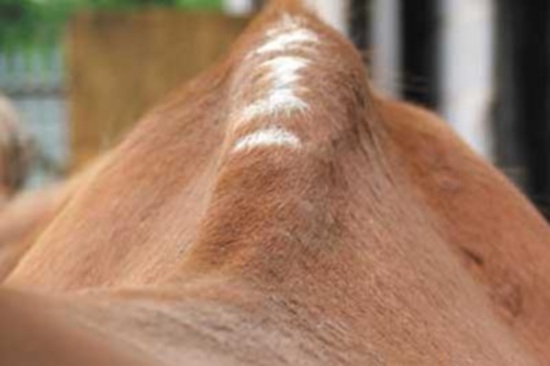
This is probably what happened to this poor, very damaged horse. (Again, a picture off the net.) Not only are the white patches evidence of damage most likely from saddle contact to the top of the spinous processes, but the severely sunken muscles behind the protruding shoulder blades show damage as well.
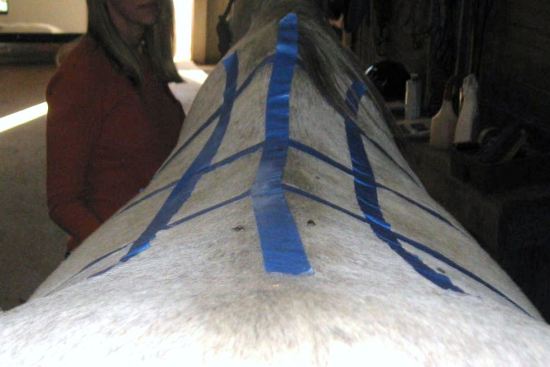
But it isn't just the gullet under the fork (pommel for English saddles) that you need to check, because this applies not just to the withers but all along the whole length of the spine, especially on single backed or A shaped horses. Unlike English saddles where the panels raise the tree (and therefore the seat) off the horse with a gap between them, with a western saddle, the groundseat or even the bottom of the cantle may contact the spine of a more A shaped horse. And it can be difficult to tell if there is clearance under a western saddle, unlike an English saddle where you can see if there is contact down the middle of the saddle.
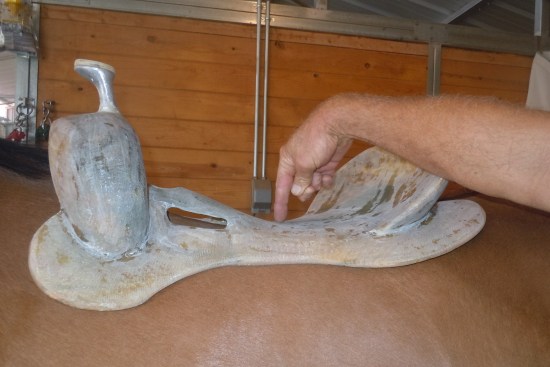
This picture was sent to us with the owner's finger pointing to where the built in fiberglass groundseat contacted the spine on his horse. He could see it with the bare tree. It would be a lot harder to know this with a finished saddle.
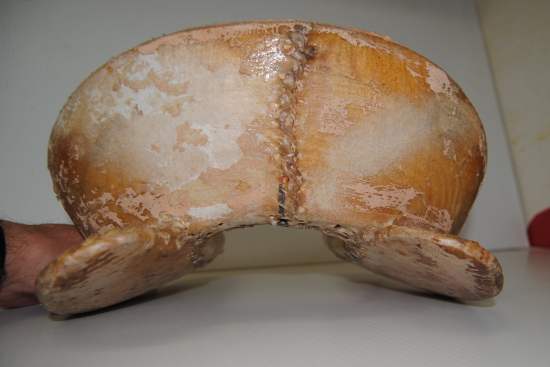
We were sent this tree to duplicate since it broke (you will notice there is no front end!), but we noticed the minimal clearance under the cantle gullet on it. While this customer had never noticed a problem with this one, we did have another tree in to duplicate where we figured the problem was direct contact with the spine under the cantle. Yes, skirts will raise the tree up off the horse a bit, but with weight in the saddle, how far will the saddle be pressed back down on the horse? On horses whose muscles rise higher than the backbone, you don't have to worry as much. But on horses where the backbone is the highest point on the back, this needs to be checked out.
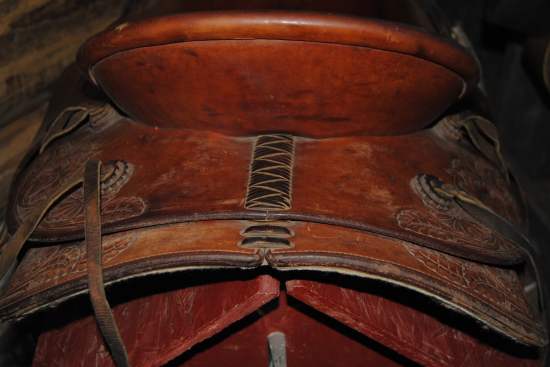
Another place to check on a Western saddle that won't be a problem on an English saddle is the lacing at the back of the skirts. Some saddles are laced. Some aren't. And depending on how the skirts are made and how the lacing is done, this area can put pressure on the spine of a horse. Looking at this saddle, the skirts actually dip down a little in the middle where they are laced together. And remember, the laces also go through the skirts, so they are below what you actually see when you look at the back of the skirts.
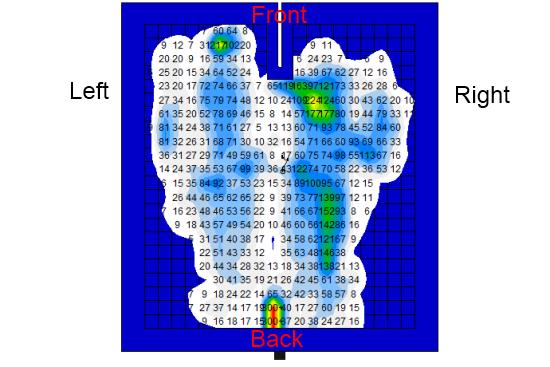
Here is a picture of the reading on our pressure pad of what this saddle looked like on horse whose muscles slope away from the back bone a bit. The red line in the middle at the back shows an area of high pressure and was definitely under the lacing of the skirts. When we tried to put our fingers under it with a rider up it was very difficult, so something easy to check by feel, once you know what to look for.
#5 Gullet/channel clearance
This principle also applies to all saddles, including treeless ones as well. Pressure has been proven to concentrate on bone. The pressure recorded at the skin or in the muscle is less than is measured at the surface of bone underlying those tissues. And pressure from a saddle isn't just down. There is also a percentage of pressure that goes in towards the middle because of the angle on the bars or panels. (Remember vectors from physics class?? Here is where they apply to the real world! And you never thought they would...) Again, for horses with muscles that bulge up above the spine, the sideways pressure on the spinous processes isn't a big problem. But on those A shape backed horses, too narrow a channel can cause major problems.
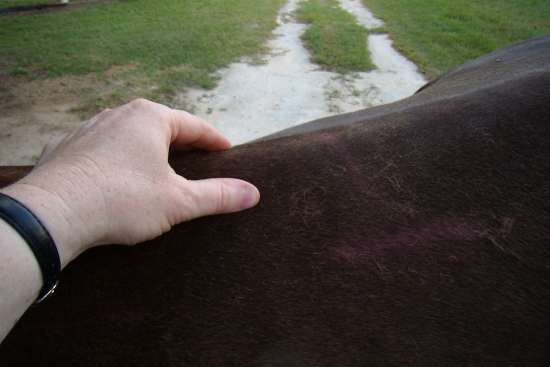
So how much space should be there? Well, you need to clear the bones for sure. Again, people give "rules" of spaces, but it really depends on the size of the horse. I had someone once tell me that they measured hundreds of hoses and the width of the spine was the same in all of them. I disagree. This is a picture of my hand showing the width of the spine on an 18 hand TB with minimal muscle. The bone and overlying ligaments, fascia, etc. had to be almost two inches wide. A smaller horse would have narrower bones. There is a marked difference in the width of the dorsal spinous processes on our miniature horse versus the pony sized mule versus the full sized QH skeletons. So size of horse does matter.
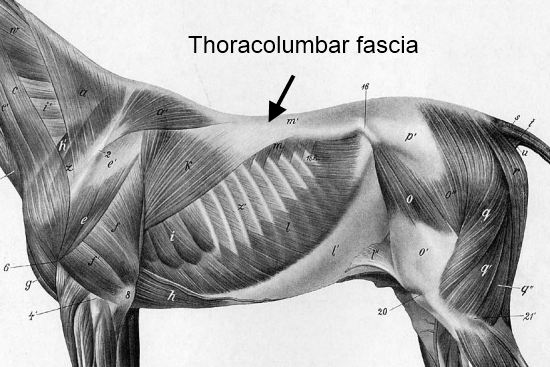
But you need to clear more than just the bone or you end up with too much pressure on the overlying fascia, etc. next to the bones. Like a saddle blanket which isn't tented up over the withers prior to cinching the saddle, the thoracolumbar fascia (which attaches to the tops of the spinous processes as it overlies the whole top of the back) will transfer pressure to the spinous processes as it is being pushed down on both sides of the bone. So how far away do you have to be? I don't really know. I don't know if anyone really knows because I don't know of any research that tests this.
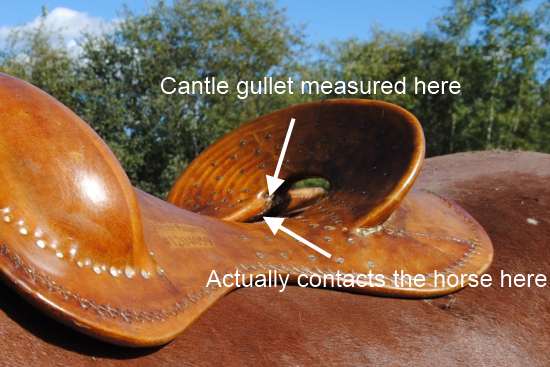
We also need to realize that "how far apart" isn't so much the minimal distance between the bars/panels as measured on the saddle, but the actual distance between where the bars/panels first contact the horse relative to the spine. This depends on both the shape of the horse (bulgy muscles rising above the level of the backbone versus the A shaped horse) and the shape of the panels/bars (lots of crown or very flat with sharper edges). But remember, as weight is applied to the saddle, the bars/panels will press into the horse, so the distance you feel or see with an empty saddle/tree will be more than what is there with a rider up.
In the long run it comes down to the horse telling us if things are too close. When you test to see if a horse is sore, don't just push down. Also push in - towards the spine. If you get a reaction, he's sore. Healthy muscle tissue doesn't hurt, and there are no reflexes or imaginary "paraspinal ligaments" along the spine that cause a reaction in your horse when you do this. If he flinches when you push in, he hurts, and too much pressure too close to the spine causes this.
Well, that's the first few, and enough for one post. I'll look at some more another time, and there won't be as much agreement with them...
